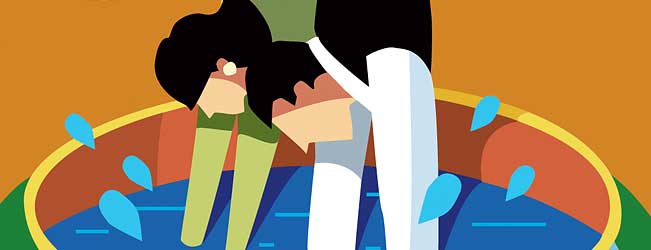

Dive Right In
The U's Study Abroad program allows students to immerse themselves
in a different culture—and change thier lives in the process.
by Ann Whitney Floor
After two years of grueling Mandarin Chinese language classes at the
U, undergrad Libby Shotwell decided it was time to go to China, time
to know Chinese rather than just study Chinese.
Through the U’s Study Abroad program, she found an opportunity
to join a group of 25 students for six weeks in Tianjin, China’s
fourth largest city. Her classes at Nankai University included daily
intensive language instruction with a professor who spoke only Chinese.
No interpreter.
“My listening skills skyrocketed,” says Shotwell. Assigned
a Chinese student as a speaking partner, she recalls, “We used
a lot of hand signals those first few weeks.” Afternoons were
spent listening to lectures—in English—on the Peking Opera,
tai chi, calligraphy, history, cuisine, and traditional music. For Shotwell,
the study abroad experience proved an effective way to bolster her U
of U education.
Shotwell found a sense of community with her fellow
students from the U—people she’d had classes with for the
past two years.
From architecture classes in Berlin to Arabic language classes in Alexandria,
Egypt, to service learning programs in Kotwara, India, or Accra, Ghana,
the choices are as varied as the students. According to Sara Demko,
assistant director for the program, nearly 450 students take the opportunity
to study abroad each summer. During fall and spring semesters, between
80 and 100 students study in foreign lands. “And the new international
requirement for undergraduates will only strengthen the program,”
she says (see sidebar on page 28).
But it isn’t always an easy glide through another culture. Shotwell
occasionally dined with the Chinese students, and sometimes there would
be a banquet with “fancier” food—delicacies that were
tough to stomach. For example, one time “They brought us pigs’
brains and snake soup,” she says. “The presentation is what
got me. Water snakes in a clear broth had been sliced in chunks, scales
and all. And then there was a snake-skin salad with greens. It was actually
pretty, in a weird way.”
Although she suffered from homesickness, which is on Study Abroad’s
list of anticipated challenges, Shotwell found a sense of community
with her fellow students from the U—people she’d had classes
with for the past two years. Familiar faces in unfamiliar China were
comforting and eased the stress that inevitably comes with living in
a foreign culture.
“Being in China made me more aware of what’s outside the
bubble of Utah,” she says, “and now I have a base for what
I plan to do in the future—to work in the international arena
on humanitarian and political issues both here and in China.”
Jake Bailey’s situation was a little different. With his undergraduate
course work completed, Bailey was waiting for word on his application
to medical school. He was trying to decide how to spend spring semester
when he dropped by the U’s Study Abroad office. As he leafed through
brochures, a staff advisor suggested he consider an international internship.
The Study Abroad program offers classes, work opportunities, and internships
in almost any country in the world.
Bailey ended up working a three-month infectious disease internship
in Mumbai (Bombay), India, from January through March 2006. He took
medical histories, gave simple exams, and attended lectures. While rotating
through different clinics and hospitals, he studied leprosy, HIV/AIDS,
and tuberculosis—not as terms in a textbook, but up close and
personal with people infected with these diseases. When he encountered
a man covered with smallpox scars, he was shocked. “I never expected
to see a person who had lived through smallpox—I thought that
had been wiped out decades ago,” he says.
Later, he examined a woman wracked with tuberculosis. He put the stethoscope
to her back to listen to her lungs but couldn’t hear anything.
No breath. The accompanying physician predicted that the woman would
be dead within a week or two.
Experiences such as this profoundly affected Bailey—and changed
the focus of his life. He still intends to go to medical school and
get a Ph.D. but plans a dissertation on infectious diseases and immunology
in international health. “I always knew that international health
could be interesting,” he says, “but now I know it’s
important. Forty percent of India’s population tests positive
for TB.”
And Bailey and Shotwell are by no means alone—every year, there’s
a new crop of traveling scholars.
“We hold a semi-annual recruitment fair in January and September,”
notes Demko. Between 500 and 600 people attend each year (the next one
is scheduled for September 13). “And you don’t need to be
a student to participate,” she adds. “The programs are open
to anyone over 18 who is interested, including members of the community.”
(The staff recommends planning nine months to one year in advance and
spending around $5,000 for a summer program.)
Demko speaks from experience. Her own interest in global issues was
piqued when she visited Poland as a pre-law undergraduate at the University
of Wisconsin. “It changed how I looked at everything and what
it meant to be from the U.S.,” she says. “Poland in 1996
was transitioning from communism to capitalism, and the influence of
the U.S. was surprising. I hadn’t been exposed to that before.
I grew up in a rural town in Wisconsin and had never considered these
things. It opened my eyes to how big the world is, how much our policy
impacts other countries, how connected we all are. Study abroad is empowering.
You feel like you can go anywhere and get along fine wherever you are.”
—Ann Whitney Floor is a writer in University Marketing &
Communications.
Read
Jake Bailey’s blog
Information
on the U’s Study Abroad program
Return to fall 2006 table of contents
|



